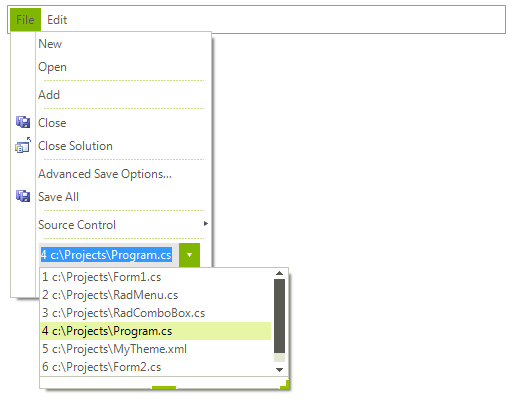

- #CHECK MENU ITEM MENUSTRIP WINFORMS HOW TO#
- #CHECK MENU ITEM MENUSTRIP WINFORMS CODE#
- #CHECK MENU ITEM MENUSTRIP WINFORMS WINDOWS#
In the end, I could only take the best of each company and modify it by myself.ġ, first create a menu TB_MENU table in the database, the field mainlyįATHER_ID- menu The parent ID of the item, or 0 if it is a top-level menu. Later, I searched the Internet for a lot of codes related to creating dynamic menus, but they were not ideal. This requires that the MenuStrip and its menu items are dynamically created when the form is loaded. People with different permissions need to use different menus. This was more convenient, but not flexible.Ī project to be done at a certain time involves the assignment of permissions.

In the past, when using this control, I only knew to manually enter the menu items in the form designer.
#CHECK MENU ITEM MENUSTRIP WINFORMS HOW TO#
I won’t say more about how to use it, but I’ll talk about my personal experience. When using menu controls in C# WinForm, I think MenuStrip is the first choice of many people. She works as a Development Manager at Citigroup.Please declare the source for reprinting: Throughout her career, she as developed many client/server and web applications, mainly for financial services companies. Irina Medvinskaya has been involved in technology since 1996.
#CHECK MENU ITEM MENUSTRIP WINFORMS CODE#
The code for the click event checks the text of the sender to determine which menu item has been clicked and shows a MessageBox with the name of that menu item. To add the menu items, you specify their names and the click event handler. In your example, you added three menu items to the MainMenu1 component on your form. Running the example results in a form that looks like this:Ĭlicking Item 2 would result in a message box showing up: MessageBox.Show("Menu '" & () & "' clicked") Public Sub ClickHandler(ByVal sender As Object, _ New EventHandler(AddressOf ClickHandler)) Private Sub Form1_Load(ByVal sender As System.Object, _īyVal e As System.EventArgs) Handles MyBase.Load You will also add the following code to your form: You will add the MainMenu component to your form. Additionally, you may want to display menu items depending on the user’s permission in the application and an ability to hide or disable certain menu items would come in handy. This may be required whenever certain menu items are to be displayed after the user takes a certain action. VB.NET allows run-time menu manipulation. After that, you can add additional MenuItems to the MainMenu by using the Add method. To bind MainMenu, you need to assign the MainMenu to the Menu property of the Form. Each Menuitem can be either a parent for the sub menu items or a command. A menu consists of MenuItem objects that represent individual menu commands. The MainMenu control represents a container for the whole menu setup structure on the form. Additionally, you can use a shortcut property to set keyboard shortcuts. This usually is done to identify a menu item that is selected in a list of multiple, mutually exclusive menu items. For example, if you need to display a check mark next to a menu item, you can use the Checked property. The MenuItem class provides properties that allow you to configure the appearance and the functionality of menu items.
#CHECK MENU ITEM MENUSTRIP WINFORMS WINDOWS#
Once you have added the control to your form, you quickly can add menus to your VB.NET windows forms. To add a MainMenu component, open the Forms Toolbox and add the MainMenu component to your form. The MainMenu control allows you to create, add, and modify menus and menu bars and set their properties in the Properties window. To add menus to your VB.NET application in design-time, you need to add a MainMenu component to your form. But, as in previous versions of VB, you can add and modify menu items either in design-time or in run-time by using methods and properties of the Menu component. The MainMenu component was not present in VB6 it was added in VB.NET.

In this article, you will take a look at creating menu items and see an example of the code to work with menus in VB.NET. Menus are often necessary in applications and it is essential that developers have an ability to manipulate them in design-time.


 0 kommentar(er)
0 kommentar(er)
